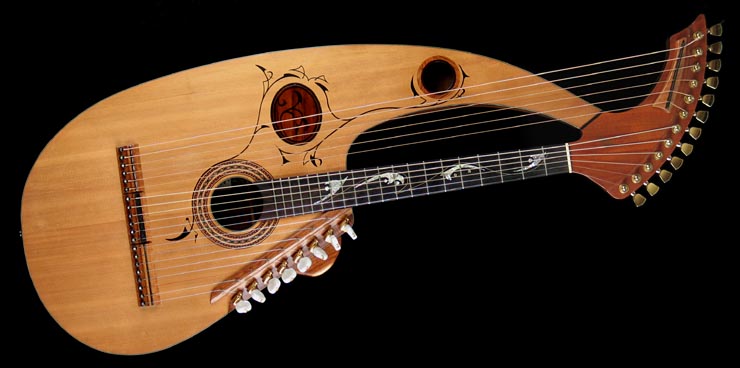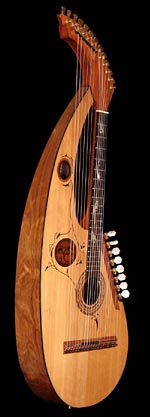

Used Sandpiper
20-string
Harp Guitar
SOLD


|
Here’s something you don’t see every
day. This is an unusual,
custom Sandpiper harp guitar built several years ago by John Westling, seen on the
Sandpiper site for awhile now. After
building several instruments – all variations on the Doan
Sullivan/Elliott theme – John retired from harp guitar construction
in 2006, choosing to stick with small harps.
I don’t know if the owner got tired of playing it or that the kids grew up, but it was sold, and turned up in an online video of an East Coast guitarist named John Cantalini. John used it for some time (apparently able to ignore the young stranger’s eyes staring up at him from the arm…), then passed it on. This is the instrument that was damaged by Fedex, which I describe in painful detail here (well worth reading, if you are ever considering shipping an instrument). I ended up eating it, and having to repair three new cracks in the bass side. At the suggestion of Kathy Wingert, I took it to her old mentor Jon Peterson, owner of World of Strings in Long Beach. As she predicted, he does "great cracks." This side now looks "like new" from most angles, though at just the right light and angle, you can see where they are. More noticeable is a nice gouged scuff in the top, plus a couple of other old hairline or repaired cracks on the sides and back (which I would call very minor). I have tried to show all these issues below. Since I'm on the subject, I'll mention all other condition negatives: General light finish, scuffs and playing scratches from normal use, a subtle but large spot of finish wear under the subs (as if the owner removed the strings and rested a sweaty palm there for quite awhile), a finish blemish on the side of the arm, and some bellying behind the bridge (discussed in more detail under "stringing" below). Having taken ownership of it, I wasn’t sure what to do about the mystery kids. While it would have been simplest to just sell it as is, and let the new owner deal with it, I didn’t want it to be a turn-off for an otherwise nice instrument. So, the creative consultants (my wife, Jaci, Frank Doucette and his wife Christa) helped come up with options. These included stripping the top to remove the photo, do something there to hide the mess and refinish it – or cut it out and make yet another soundhole – or cover it with some sort of “reversible” visual improvement. Ultimately, that’s what we did. Though I pushed for affixing there my personally dedicated photo from John Doan, instead, Christa designed a nice piece of art to match what was already there, and did her practiced “faux wood finish” thing over the finish.
So we’ve covered that. Other aesthetics I personally consider odd choices, but to others, this might be a real distinctive instrument. The pearl and wire inlay on the fingerboard and black inkline artwork on the soundboard (original, under the finish) are wonderful, as is the delightful subtle sandpiper bird on the headstock. The classical style rosette is nicely done, if incongruent. The odd body and arm shape was intended by Westling to make reaching all the strings easier, and it does. No, the extra cubic inches where the waist would normally be is not in your way in any playing position, and that little extensions helps keep the instrument on your (either) leg. There is a design flaw, and that is the geometry of the sub-bass tuners to the sub-bass nut. Some sort of strange silk and steel strings were on here (the subs), and, in fact, that is what would be best on this instrument (actually, silk and bronze is the ideal). They would have to be custom ordered from Pyramid Strings in Germany (easy to do, but a little pricey). Strangely, this instrument is fan-braced, like a classical guitar, so I imagine it was designed (for the owner) to emulate John Doan's instrument, with its nylon sub-basses (even though the Sandpiper site states that harp guitars are "steel strung."). Unfortunately, despite my best efforts, it has proven virtually impossible to string it with La Bella nylon strings due to their inherent stretchiness. In other words, long before you can get the string up to pitch, it has slipped off its post, which is a good half inch behind the bass nut. It doesn't matter how hard or lightly you pull the string through the post (I tried stretching nearly two inches!), or how many windings you aim for...it won't work. (I know, I'm killing my sale here, but this hands-on-experience and honesty is what the "pope's blessing" is all about...) I can provide any interested party photos of my attempts and throw in the strings and they are welcome to have at it. Meanwhile, I had no option but to use standard phosphor bronze strings - these (like silk & steel) have little stretch, and so few windings are required, and they will easily stay behind the miniscule "lip" of the tuner end. I went very light (compared to all other Dyer-type harp guitars) - twenty pounds or less per string. They still sound OK, as long as you are a medium to light sub player, and still way better (in my opinion) than the flabby and soft nylon subs, the latter having a nicer, deeper "oomph," but little else (like sustain). Note: Everything is still working on this guitar - neck angle, action, intonation are all pretty good, but with the bellying demonstrating that this cannot take full-on steel tension, I would highly advise against it, and would recommend eventually settling on silk & bronze for the neck to match custom silk & bronze for the subs. Right now I have Elixers on the neck (like John Doan's instrument, I was trying to "soften" the harsh transition to the nylon subs) - it would probably sound great (probably better) with either plain light phosphor bronze or silk and bronze. The super-trebles are all .012s of the new DR coated, color-coded strings sets I sell (red C and blue F, just like a harp!). It easily passes the "Doan Test" of playing the C, then D on the first string, then the first super (E) - and hearing a smooth, continuous harp-like scale. That, more than anything, makes me want to get one of these one day! All in all? Though I can’t A/B test it, I think this actually sounds as good, and perhaps better than that gorgeous Milburn HG I sold awhile back - a little louder, open and resonant. Note that bridge is separated into three distinct individual bridges (inspired by cutting into thirds the original Sullivan/Elliott bridge for better response). We've discussed the special appointments, all that's left is the materials. Again, interesting choices. The back is koa, while the sides are Honduras rosewood (I've never seen the latter myself - how about you?). Fit and finish were (originally) a solid 9. |
||||
|
Sorry,
no case – options here. Pricing: This was a tough one (I did not factor in any of my after-purchase expenses). Frankly (and honestly), I’d put this at about the $8,000-10,000 range if this was a brand new instrument ordered today. I’m knocking off one grand at a time for A) overall used condition, B) additional side repairs, C) funky arm artistic element, and D) general "non-standard" aesthetics. Hmmm…that
puts it at four to six grand. Too
much! Let’s do $3750,
and get you into that John Doan world of 20 strings as quickly and
painlessly as possible. -Gregg Miner, the "harp guitar pope" |
|||||
|
Specifications:
Price: |
|||
|
|||
|
CDs &
DVDs by Stephen Bennett, John Doan, Muriel Anderson, Andy McKee,
Stacy Hobbs, Tom Shinness, Dan LaVoie, James Kline, Larry
Berwald, Bill Dutcher, Gregg Miner, Pasquale Taraffo |
All Site Contents © 2006,
2007, 2008, 2009, 2010, 2011, 2012, 2013

PO Box 573155
Tarzana, CA 91357
USA
(818) 884-7937